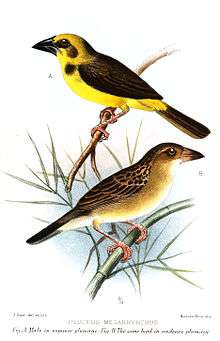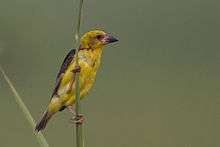Finn's weaver
Finn's weaver or Finn's baya (Ploceus megarhynchus), also known as yellow weaver is a species of weaver bird found in the Ganges and Brahmaputra valleys in India and Nepal. Two races are known; the nominate from the Kumaon area and salimalii from the eastern Terai.

| Finn's weaver | |
|---|---|
 | |
| Male from Baur Reservoir Uttarakhand | |
| Scientific classification | |
| Kingdom: | Animalia |
| Phylum: | Chordata |
| Class: | Aves |
| Order: | Passeriformes |
| Family: | Ploceidae |
| Genus: | Ploceus |
| Species: | P. megarhynchus |
| Binomial name | |
| Ploceus megarhynchus Hume, 1869 | |
The species was named by Hume based on a specimen obtained at Kaladhungi near Nainital. The species was rediscovered in the Terai near Calcutta by Frank Finn.[2] Oates called it "The Eastern Baya" in 1889 and Stuart Baker called it Finn's baya in the second edition (1925) of the Fauna of British India.[3][4][5]
Ecology
They breed from May to September.[6] The nest is built on top of trees or in reeds. The nest is different in structure from the other weaver species found in India, but as in other weavers, woven from thin strips of leaves and reeds. This species lines the entire inside of the nest, unlike the other weavers, which line only the floor of the nest. Males strip the leaves of the nest tree, making the globular nests clearly visible.
References
- BirdLife International (2012). "Ploceus megarhynchus". IUCN Red List of Threatened Species. 2012. Retrieved 26 November 2013.CS1 maint: ref=harv (link)
- Beolens, B.; Watkins, M. (2003). Whose bird? Men and women commemorated in the common names of birds. Christopher Helm. (Note: this source incorrectly notes that Finn collected the Kaladhungi specimen. The type specimen was collected for or by Hume and Finn was still a child.)
- Baker, ECS (1925). Fauna of British India. Birds. Volume 3 (2nd ed.). London: Taylor and Francis. pp. 69–70.
- Oates, EW (1890). Fauna of British India. Birds. Volume 2. London: Taylor and Francis. pp. 177–178.
- Abdulali, Humayun. "Finn's baya (Ploceus megarhynchus Hume)". Journal of the Bombay Natural History Society: 200–204.
- BirdLife International (2009) Species factsheet: Ploceus megarhynchus. BirdLife International: Yellow Weaver
Other references
- Abdulali, H. (1952) Finn's Baya Ploceus megarhynchus (Hume). J. Bombay Nat. Hist. Soc. 51(1): 200–204.
- Abdulali, H. (1954) More notes on Finn's Baya (Ploceus megarhynchus). J. Bombay Nat. Hist. Soc. 52(2&3): 599–601.
- Abdulali, H. (1961) The nesting habits of the eastern race of Finn's Baya Ploceus megarhynchus salimalii (Abdulali). J. Bombay Nat. Hist. Soc. 58(1): 269–270.
- Ali, S. (1935) Mainly in quest of Finn's Baya. Indian Forester 41(6): 365–374.
- Ali, S., Crook, J. H. (1959) Observations on Finn's Baya (Ploceus megarhynchus Hume) rediscovered in the Kumaon terai, 1959. J. Bombay Nat. Hist. Soc. 56(3): 457–483.
- Ambedkar, V.C. (1968) Observations on the breeding biology of Finn's Baya (Ploceus megarhynchus Hume) in the Kumaon Terai. J. Bombay Nat. Hist. Soc. 65(3): 596–607.
- Hart, W.C. (1937) Finn's Baya Ploceus megarhyncheus Hume). Indian Forester 43(1): 45–46.
- O'Donell, H.V. (1916) The Eastern Baya Ploceus megarynchus nesting in the same tree as the Jungle Bee Apis indicus. J. Bombay Nat. Hist. Soc. 24(4): 821.
- Rai, Y. M. (1979) Observations on Finn's Baya breeding near Meerut. Newsletter for Birdwatchers . 19(11): 11.
- Rai, Y.M. (1979) Finn's Baya breeding at Meerut. Newsletter for Birdwatchers . 19(7): 11.
- Rai, Y.M. (1983) Hastinapur birds: Finn's Baya; Tawny Eagle; Crested Honey-Buzzard. Newsletter for Birdwatchers . 23(7-8): 14–15.
- Saha, S.S. (1967) The Finn's Baya Ploceus megarhynchus Hume [Aves: Passeriformes: Ploceidae] and its breeding colony near Calcutta. Proc. Zool. Soc. Calcutta 20: 181–185.
- Saha, S.S. (1976) Occurrence of Finn's Baya (Ploceus megarhynchus Hume) in Darrang District, Assam. J. Bombay Nat. Hist. Soc. 73(3): 527–529.
External links
- Finn's weaver - Species text in Weaver Watch.
